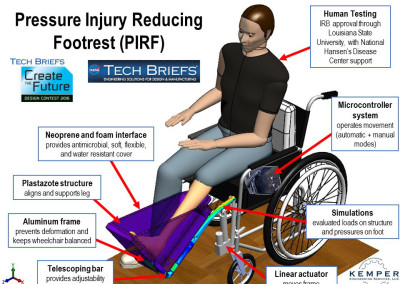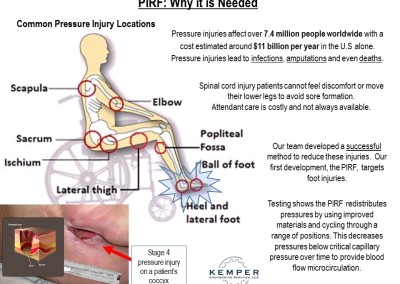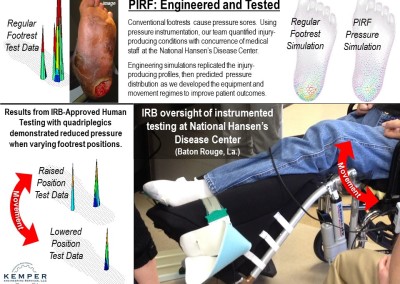Development: Pressure Injury Reducing Footrest
Pressure injuries affect over 2.5 million people in the United States and over 7.4 million people worldwide. In the US they plague 20% of paraplegics and 26% of quadriplegics and create a wound care cost estimated around $11 billion per year. Diabetics, people with prosthetics, and others are also prone to pressure injuries. Our team has developed a novel approach that can alleviate the suffering of millions, reducing injury formation and thus infections, amputations and even deaths. We have proven our approach using a Pressure Injury Reducing Footrest (PIRF) through IRB-approved testing.
Pressure injuries result from prolonged, unrelieved pressure causing damage to the skin and underlying tissues. Spinal cord injury patients are particularly prone to this kind of injury due to inability to sense discomfort from pressure and reposition in response. Keeping skin clean and dry, caretakers repositioning susceptible areas, reducing shear and friction, and using prophylactic dressings or electrical stimulation are all methods that attempt to reduce likelihood of sore formation. Sore formation on lower extremities is not adequately addressed due to cost, complexity, and effectiveness of current treatment strategies.
Our innovation is to use a combination of materials and motion to reduce pressure below research-proven thresholds for injury formation. Materials used are typical of the healthcare industry. Using ergonomics, kinematics, and structural analysis, we developed and tested a prototype leg rest that cycles through a range of positions. The PIRF was made to be easily operable, durable, and safe in order to be marketable to wheelchair manufacturers and suppliers, and medical and physical therapy facilities. The design shown here is for mature markets. We also have designs suitable for challenged regions.
Results from short term human testing are consistent with m edical research and indicate successful reduction of peak pressures and redistribution of pressure centers. The device was automated to cycle positions so that no single area of the foot is more vulnerable to injury formation.
Volunteers for the IRB-approved testing included quadriplegics, paraplegics, and those without spinal injuries, giving us the full spectrum of potential users. Volunteers evaluated the device for comfort, ease of use, noise level, aesthetics, timing of cycles, and leg rest adjustability, with each aspect receiving an average response of highly to extremely satisfied. The PIRF would assist in preventing pressure sores on wheelchair-bound people, ultimately reducing patient suffering, improving quality of life for patients and their caregivers, and reducing wound care costs. These successes indicate we can apply our methods to reduce pressure injury formation on other body regions.
Kemper Engineering Services develops, troubleshoots, and innovates equipment and systems for a wide range of industries, including medical devices. We are a woman-owned, service-related disabled veteran-owned small business.
We wish to thank the National Hansen’s Disease (Leprosy) Center, located in Baton Rouge, La., for all of their support. It provides tremendous focus when you are working with some of the people most impacted by a condition. We are also grateful for Louisiana State University and their Capstone Engineering Program, which provided the initial platform for this interdisciplinary engineering development. After graduation Bart worked with Amy and Linda to help them take 3rd Place in the national ASME/NSF Undergraduate Design Project Competition in Rehabilitative and Assistive Devices.
This project has personal connections to our team. The company owner is a disabled combat veteran, often needing a cane and sometimes a wheelchair. Our principal engineer is also a combat veteran with over 30 years of service and knows veterans who are disabled due to combat or service-related conditions. The original team leader, Amy Pinner (EI), was motivated to become an engineer because of her father, a chemical engineer who was paralyzed for two years prior to his death. The current team lead, Linda Cross (EI), is a biological engineer and part of her reason for joining KES is to work on this and other medical projects. Kemper Engineering has financed this project but support is needed to continue this effort and bring relief to millions. To read about how we became involved in this project, go here.



